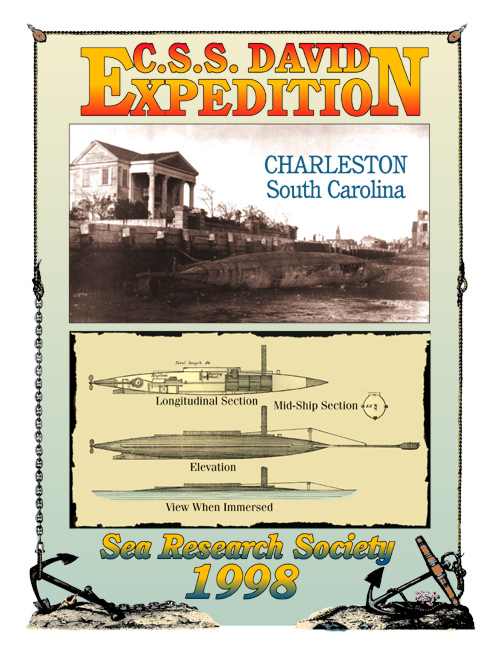Sea Research Society Archaeological team seeking remains of two Confederate torpedo boats buried under Charleston's historic Tradd Street
NOTE: This is a January 18,
1998 news release and is maintained here for reference purposes only. Old
contact information and links have been.
 View this poster in full page. |
Charleston, SC--January 18, 1998
While most of Charleston slept this morning, a team of dedicated explorers was using ground penetrating radar (GPR) to probe the earth under Tradd Street in hopes of finding evidence of two small Confederate sea warriors known as "Davids." The expedition, which is jointly sponsored by Sea Research Society and Narwhal Press Inc., is headed by underwater archaeologist, Dr. E. Lee Spence, who is the Society's president. Spence is internationally known for his many discoveries and has authored more than two dozen books on shipwrecks. The GPR is being operated by Claude E. "Pete" Petrone, who has previously used the sophisticated and highly specialized equipment to search Mayan ruins and Egyptian tombs. Petrone recently retired from National Geographic Society and is considered the foremost expert in the use of GPR.
|
|
The expedition is expected to last several days. "We are hoping to detect the remains of at least one of two 50-foot steam-driven torpedo boats," said Spence. The boats are believed to have been partially destroyed during the Confederate evacuation of Charleston in 1865. Contemporary photographs and records show the partially wrecked vessels on a mud flat next to a seawall now covered by present-day Tradd Street. Spence, who believes the two vessels were simply abandoned and covered with fill instead of removed, first advanced his theory on their continued existence over twenty years ago. Several of the buildings, including a beautiful Antebellum mansion with huge white columns, visible in the Civil War photographs, are still standing and are being used to triangulate the exact location of the two wrecks. Describing the project as a remote-sensing expedition using both GPR and magnetic pulse induction detectors, Spence made it clear that "absolutely no excavations will be made by our team. All rights to the discoveries will be donated to the City of Charleston. The City can then decide what to do with the historic wrecks." Spence hopes that at least one of the two cigar-shaped vessels will eventually be unearthed by the City and put on display at the Charleston Museum. Research indicates that one of the two boats is the original David, which Spence says was "considered by many to be the greatest technological innovation in naval warfare in over 2,000 years." Steam powered and designed to operate very low in the water, David was double-ended and resembled a submarine; she was, however, strictly a surface vessel. David torpedoed U.S. ironclad New Ironsides at the mouth of Charleston Harbor on October 5, 1863. The ironclad survived, but the attack made history by clearly demonstrating the potential value of torpedo boats. The attack made such an impression on the Federal naval commanders that every imaginable precaution was taken to guard against future attacks, and high steam was thereafter carried at night on all the vessels so that they could move at speed in an instant. The name "David" came to be a generic term which was also applied by both sides to a number of similarly shaped vessels including the Hunley, which became the first submarine in history to sink an enemy ship.
On site for the Sea Research Society expedition, in addition to Spence and
Petrone, are cameraman Bill Smith; videographer Matthew Spence; support crew
Tree Martschink, Willette Smith, Terry Frazier, and Roni Smith. Stan Fulton,
Executive Editor of Narwhal Press Inc., is in charge of logistics. Technical
support, pulse detectors and other equipment were provided courtesy of Narwhal
Press Inc., White's Electronics, Inc., Spence, Petrone, and National Geographic
Society.
|
|